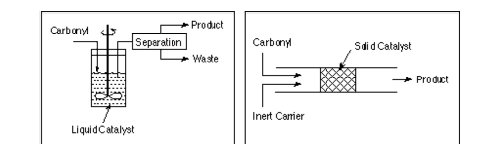Grantee Research Project Results
Final Report: Pollution Prevention in Industrial Condensation Reactions
EPA Grant Number: R825331Title: Pollution Prevention in Industrial Condensation Reactions
Investigators: Spivey, James J. , Jang, Ben W-L. , Nikolopoulos, Apostolos A. , Howe, Gary B. , Olsen, David J. , Devon, Tom J. , Culp, Robert D.
Institution: Desert Research Institute
EPA Project Officer: Aja, Hayley
Project Period: October 1, 1996 through September 30, 1999
Project Amount: $359,906
RFA: Technology for a Sustainable Environment (1996) RFA Text | Recipients Lists
Research Category: Pollution Prevention/Sustainable Development , Sustainable and Healthy Communities
Objective:
The objective of this project was to develop heterogeneous acid-base catalysts to increase the economic and environmental performance of the traditional homogeneous catalysts used to make industrially important condensation products.
Summary/Accomplishments (Outputs/Outcomes):
The condensation/hydrogenation of acetone to methyl isobutyl ketone (MIBK) was studied on a series of Ni- and Pd-supported oxide catalysts and a series of Pd- and Pt-supported hydrotalcite (HTC) catalysts. The reaction experiments were performed in a high-pressure reactor vessel equipped with a micro-Robinson catalyst basket, in a semi-batch mode (liquid acetone, gaseous H2 reactant, and N2 diluent) under moderate temperatures (100?150?C) and elevated pressures (350?400 psig).
Figure 1. Comparison of traditional indusgtrial homogenous-catalyst aldal condensation
process and examined hetrogeneous-catalyst aldol condensation process (which
eliminates the waste stream)
The synthesis of MIBK from acetone condensation has been demonstrated on noble-metal-supported hydrotalcites (Pd/HTC and Pt/HTC). This process offers significant advantages over the traditional three-step homogeneously catalyzed acetone-to-MIBK process (Figure 1). It is environmentally benign because it does not generate strongly basic wastewater streams. Finally, it is potentially economically attractive because it eliminates the cost-intensive product separation and waste disposal steps found in the traditional MIBK formation process.
The results of this study indicate the complexity of maximizing the formation of MIBK by the acetone condensation/hydrogenation on multifunctional catalytic systems. The Pd/HTC and Pt/HTC catalysts showed up to 35 percent yield to MIBK with minimal byproduct formation (mainly IPA). The highest MIBK yield was obtained on the 0.1 percent Pd/HTC catalyst, indicating that minimal hydrogenation activity was required for the MO-to-MIBK reaction. Pd was more selective to MIBK than Pt at every loading, despite similar acetone conversions for Pd/HTC and Pt/HTC catalysts. Acetone conversion was directly related to the acidity/basicity of the catalyst, which were properties of the support rather than the metal. Higher hydrogenation activity (higher metal loading, Pt instead of Pd) resulted in greater selectivity to IPA.
The yield and selectivity of MIBK showed a maximum with reaction temperature on a 0.1 percent Pd/HTC catalyst. Increasing the reaction temperature from 99?C to 153?C resulted in enhanced acetone conversion, but it also tended to shift product selectivity towards undesirable over-condensation products (mainly C9 cyclic species), thus severely limiting the yield of MIBK.
The catalysts studied have both condensation and hydrogenation activity. The relative rates of these two reactions changed with reaction temperature, with a temperature increase strongly favoring condensation over hydrogenation. Consequently, the yield of MIBK would be expected to show a maximum with reaction temperature on any multifunctional acetone condensation catalyst, but the position of this maximum would be determined by the balance between the acidic/basic and hydrogenation properties of a particular catalyst.
Journal Articles:
No journal articles submitted with this report: View all 8 publications for this projectSupplemental Keywords:
pollution prevention, clean technologies, waste minimization, environmental chemistry, acetone, aldol, butyraldehyde, condensation, diacetone alcohol, hydrotalcite, mesityl oxide, methyl isobutyl ketone, palladium, platinum, 2-ethyl hexanol, 2-ethyl hexanal., Sustainable Industry/Business, RFA, Scientific Discipline, Technology for Sustainable Environment, Sustainable Environment, Environmental Chemistry, Economics and Business, cleaner production/pollution prevention, Environmental Engineering, waste minimization, acid-base catalysts, acidic dehydration function, cost reduction, pollution prevention, environmentally conscious manufacturing, oxochemicals, condesation reactions, in-process changes, industrial condensation reactions, alternative materials, cleaner production, waste reduction, industrial innovations, industrial process, innovative technologyRelevant Websites:
Progress and Final Reports:
Original AbstractThe perspectives, information and conclusions conveyed in research project abstracts, progress reports, final reports, journal abstracts and journal publications convey the viewpoints of the principal investigator and may not represent the views and policies of ORD and EPA. Conclusions drawn by the principal investigators have not been reviewed by the Agency.

